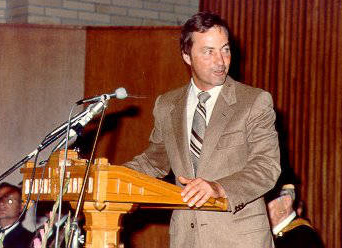The University of British Columbia’s quest to understand and treat Alzheimer’s disease is being bolstered intellectually and technologically thanks to three gifts from Charles Fipke, whose geological discoveries made Canada one of the leading producers of diamonds.
Fipke has given $3 million to endow a professorship dedicated to Alzheimer’s research, and has pledged $600,000 to outfit the professor’s lab with cutting-edge equipment at the Djavad Mowafaghian Centre for Brain Health, a partnership between the UBC Faculty of Medicine and Vancouver Coastal Health. He has also committed $5.5 million to support the purchase of the most novel and coveted brain imaging technology.
Fipke, from Kelowna, was moved to make the gifts by the plight of his longtime friend, Bill Bennett, the former Premier of British Columbia, who suffers from Alzheimer’s disease. His son Brad expressed the Bennett family’s gratitude at a ceremony today honouring Fipke’s philanthropy to UBC.
“Our family is incredibly grateful to Chuck Fipke for this generous donation to Alzheimer’s research and we are very moved by his reasons for doing it,” Brad Bennett said. “The end game has to be to find a cure for this. We still don’t know what causes this disease and there are far too many people afflicted with it and far too many families like ours suffering the horrible consequences. They say with Alzheimer’s patients you say good-bye twice, the first of those being the most difficult because you’re saying good-bye to the person you knew and loved while they are still alive.”
Dr. Haakon Nygaard, the new Fipke Professor in Alzheimer’s Research, has joined the Faculty of Medicine from the Yale School of Medicine. He will be seeing patients and conducting research in the recently opened Djavad Mowafaghian Centre for Brain Health, which unites under one roof UBC’s and Vancouver Coastal Health’s scientific and clinical expertise across neuroscience, psychiatry and neurology.
Fipke also pledged funds for a machine that combines positron emission tomography (PET) and magnetic resonance imaging (MRI). The PET-MRI will enable Dr. Nygaard and other scientists to conduct studies that wouldn’t be possible using two machines separately.
“I was stunned to learn about Bill Bennett’s illness – yet another great mind stricken by Alzheimer’s,” Fipke said. “I want to do anything I can to help UBC’s researchers find a cure.”
A UBC alumnus, Fipke had previously given $8.7 million to the University, mostly for buildings and equipment at UBC’s Okanagan campus.
Fipke is putting UBC at the global forefront of Alzheimer’s research, UBC President Dr. Arvind Gupta said. “Investing in the most creative, dedicated and determined scientists, and putting the most sophisticated technology at their fingertips is the surest means to making breakthroughs against this disease,” Gupta said.
These gifts contribute to UBC’s start an evolution campaign, the most ambitious fundraising and alumni engagement campaign in Canadian history, with the twin goal of raising $1.5 billion and involving 50,000 alumni annually in the life of the university by 2015.

L-R: Haakon Nygaard, the Fipke Professor in Alzheimer’s Research, in his lab, describes the biology of the neurodegenerative disease to donor Chuck Fipke. Photo credit: Martin Dee
A Canadian pioneer
A geologist, prospector and entrepreneur, Fipke’s latest donation stems from a lifelong passion for exploration.
After earning his B.Sc. (Geology) from UBC in 1973, he traveled the world (Papua New Guinea, South America, Australia, South Africa) for various mining companies, and opened his own mineral separation lab in Kelowna, becoming an expert on “indicator minerals” that signal the presence of diamonds.
Later, he struck out on his own, spending weeks in the back country near the Arctic Circle before finding high concentrations of diamonds at Lac de Gras, in the Northwest Territories, in 1991. He partnered with BHP Billiton to establish the Ekati Mine, the first commercial diamond mine in North America, thus jump-starting the Canadian diamond industry, which in 2011 accounted for 18 percent of the world’s rough diamond production by value, ranking third behind Russia and Botswana.
An avid horse breeder whose stable has included Golden Soul, a second-place finisher in 2013’s Kentucky Derby, Fipke has given or pledged more than $17 million to UBC. The Charles Fipke Centre for Innovative Research on the Okanagan campus honours his first gift of $6 million in 2006.
A primer on Alzheimer’s disease
The most common cause of dementia among older people, Alzheimer’s disease is an irreversible, progressive brain disease that slowly destroys memory and thinking skills, and eventually the ability to carry out the simplest tasks. Symptoms usually appear after age 60. In its most severe state, a person must depend completely on others for basic activities of daily living.
Two hallmarks of the disease are plaques (clusters of a protein, amyloid beta, that form outside neurons) and tangles (twisted strands of another protein, tau, that form inside neurons). The disease leads to the widespread destruction of neurons and the subsequent shrinkage of the brain. Although some drugs can slow the progression of symptoms in certain people, they don’t treat the underlying disease.
In 2011, 747,000 Canadians were living with dementia, a number expected to rise to 1.4 million by 2031. The combined direct (medical) and indirect (lost earnings) cost of dementia in Canada is $33 billion, expected to rise almost nine-fold by 2040. Dementia has become a focus of the Group of 8 nations, which convened health summits in the past year to catalyze global research efforts that include UBC.
Another leader felled by Alzheimer’s
Bill Bennett’s legacy as Premier of B.C. includes Expo 86, Skytrain, the Vancouver Trade and Convention Centre, the Coquihalla Highway, the development of Whistler Resort and the Alex Fraser Bridge, the expansion of BC Hydro’s hydroelectric generating capacity and the development of natural resource infrastructure throughout northern B.C.
He became a Member of the Legislative Assembly in 1973, was elected Premier just two years later, and then was re-elected Premier in 1979 and 1983. He retired from politics in 1986. His battle with Alzheimer’s parallels that of former U.S. President Ronald Reagan and former U.K. Prime Minister Margaret Thatcher – towering political figures in their day whose subsequent impairment demonstrated the disease’s capacity to debilitate even the most vigorous, outgoing personalities. Now 82, Bennett resides in a care facility.
A young scientist with new ideas
A native of Norway who earned his medical degree in Nebraska, Dr. Nygaard spent the past decade at the Yale School of Medicine in Connecticut – first as a neurology resident, then as a PhD student, and finally as a faculty member, where he was founding Co-Director of Yale’s Memory Disorders Clinic. His interest in Alzheimer’s disease was sparked while working with a Nebraska physician who saw many patients with the disease.
“I like working with older people,” he says. “I connect with them.”
At UBC, Dr. Nygaard has mapped out several research projects:
- Co-leading an $11 million study funded by the U.S. National Institutes of Health examining whether saracatinib, a drug developed for cancer, can curb the progression of Alzheimer’s disease. He and his collaborators at Yale completed the first phase in Connecticut earlier this year, showing that the drug is safe in the short-term; the next phase will aim to show, using PET, that the drug can arrest an Alzheimer’s-specific decline in metabolic activity in certain parts of the brain. The trial will enroll 152 patients at as many as 20 sites, including Vancouver.
- Collecting DNA samples of cognitively healthy people over 100 years old, searching for shared genetic characteristics that aren’t present in people who develop dementia. By identifying such genes, Dr. Nygaard hopes to determine what proteins they produce and give drug developers new targets for a disease that currently lacks effective treatment.
- Studying the potential of anti-convulsant drugs in delaying or reversing Alzheimer’s disease. Dr. Nygaard believes that Alzheimer’s disease might result from abnormally high brain activity, with epilepsy being the extreme form of such hyperactivity. The elevated activity might lead to over-production of the protein beta-amyloid, which then accumulates to the point of toxicity. At Yale, he was the lead author of a study showing that one anti-convulsant leads to a dramatic improvement of memory in mouse models of Alzheimer’s disease.
Advanced technology
Positron emission tomography (PET) can assess brain chemistry using radioactive tracers, while magnetic resonance imaging (MRI) can assess the brain’s structure, activity and connectivity.
Fipke’s gift will enable UBC to become one of only a handful of sites worldwide to have a PET-MRI machine used exclusively for brain research. The integration of both technologies will help spot plaques and tangles in the brain a decade or more before symptoms appear, creating a crucial opportunity to focus on prevention.


